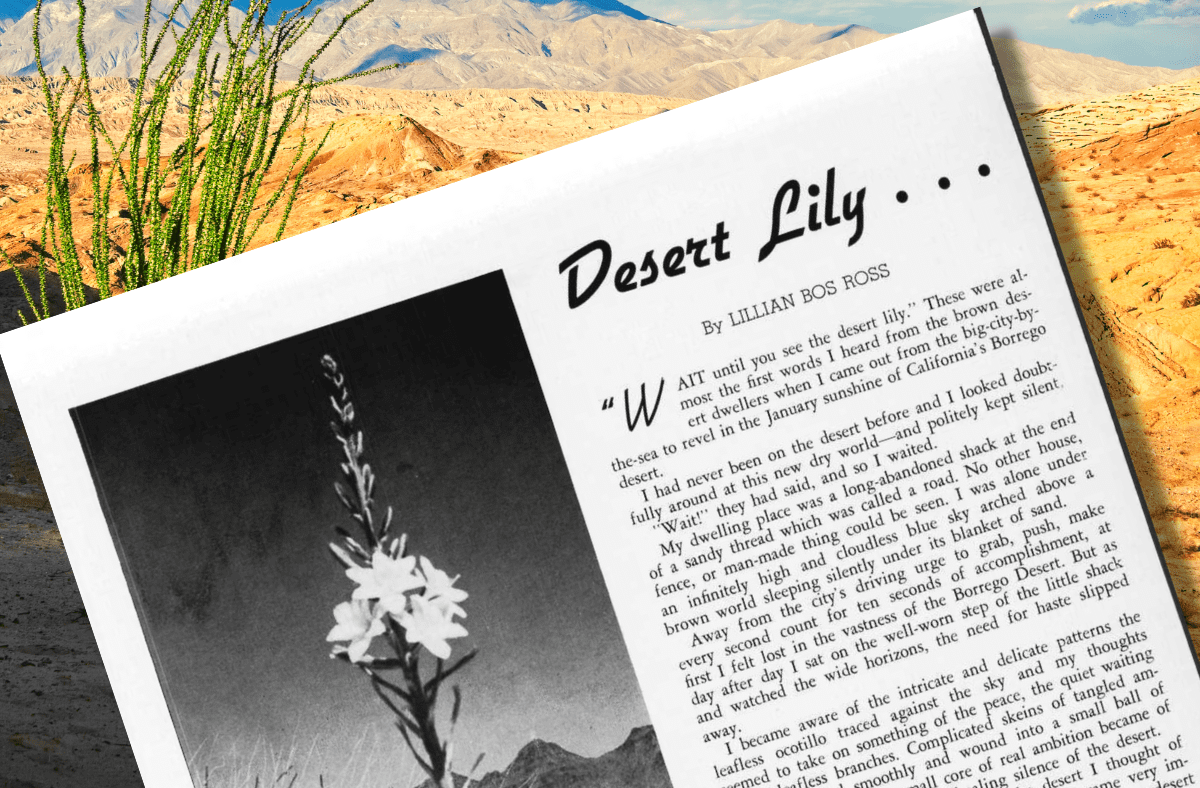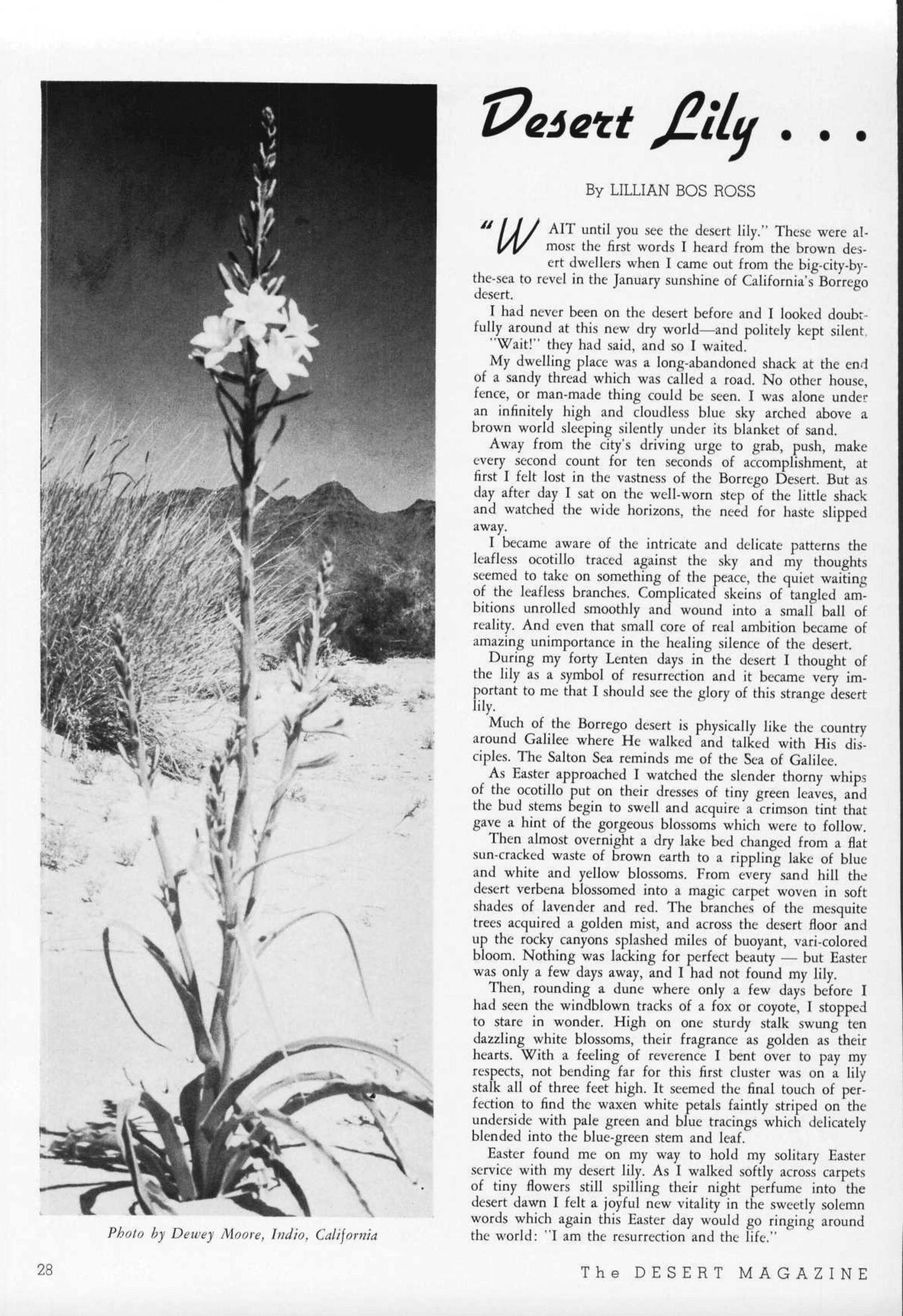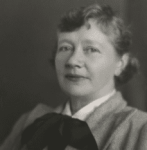
An Easter Lily From The Past
In our constant internet exploration, we came across a personal account from the 1939 edition of Desert Magazine. The author and pioneering woman, Lillian Bos Ross, describes her forty-day stay in California’s Borrego Desert, initially feeling lost in the vastness but eventually finding solace in the healing silence of the landscape. The article highlights the desert’s beauty during Easter time, with colorful blooms and the search for the elusive desert lily. Ross finds the lily and uses it as a symbol of resurrection, holding a solitary Easter service in its presence. Her story portrays a deep connection between herself and the desert landscape, emphasizing the spiritual significance that can be found in nature. and the spiritual significance that can be found in nature.
Desert Lily: Original Article on Desert Magazine 1939

Desert Lily
By: Lillian Bos Ross (copied verbatim)
“Wait Until You See the Desert Lily” These were almost the first words I heard from the brown desert dwellers when I came out from the big-city-by-the-sea to revel in the January sunshine of California’s Borrego desert. I had never been on the desert before and I looked doubtfully around at this new dry world—and politely kept silent “Wait!” they had said, and so I waited.
My dwelling place was a long-abandoned shack at the end of a sandy thread which was called a road. No other house, fence, or man-made thing could be seen. I was alone under an infinitely high and cloudless blue sky arched above a brown world sleeping silently under its blanket of sand. Away from the city’s driving urge to grab, push, make every second count for ten seconds of accomplishment, at first I felt lost in the vastness of the Borrego Desert. But as day after day I sat on the well-worn step of the little shack and watched the wide horizons, the need for haste slipped away. I became aware of the intricate and delicate patterns the leafless ocotillo traced against the sky and my thoughts seemed to take on something of the peace, the quiet waiting of the leafless branches.
Complicated skeins of tangled ambitions unrolled smoothly and wound into a small ball of reality. And even that small core of real ambition became of amazing unimportance in the healing silence of the desert. During my forty Lenten days in the desert I thought of the lily as a symbol of resurrection and it became very important to me that I should see the glory of this strange desert lily. Much of the Borrego desert is physically like the country around Galilee where He walked and talked with His disciples. The Salton Sea reminds me of the Sea of Galilee.
As Easter approached I watched the slender thorny whips of the ocotillo put on their dresses of tiny green leaves, and the bud stems begin to swell and acquire a crimson tint that gave a hint of the gorgeous blossoms which were to follow. Then almost overnight a dry lake bed changed from a flat sun-cracked waste of brown earth to a rippling lake of blue and white and yellow blossoms. From every sand hill the desert verbena blossomed into a magic carpet woven in soft shades of lavender and red. The branches of the mesquite trees acquired a golden mist, and across the desert floor and up the rocky canyons splashed miles of buoyant, vari-colored bloom.
Nothing was lacking for perfect beauty — but Easter was only a few days away, and I had not found my lily. Then, rounding a dune where only a few days before I had seen the windblown tracks of a fox or coyote, I stopped to stare in wonder. High on one sturdy stalk swung ten dazzling white blossoms, their fragrance as golden as their hearts. With a feeling of reverence I bent over to pay my respects, not bending far for this first cluster was on a lily stalk all of three feet high. It seemed the final touch of perfection to find the waxen white petals faintly striped on the underside with pale green and blue tracings which delicately blended into the blue-green stem and leaf.
Easter found me on my way to hold my solitary Easter service with my desert lily. As I walked softly across carpets of tiny flowers still spilling their night perfume into the desert dawn I felt a joyful new vitality in the sweetly solemn words which again this Easter day would go ringing around the world:
“I am the resurrection and the life.”
About the author (2012)
Information found on Google Books

Lillian Bos Ross and her husband Harry Dicken Ross first backpacked into Big Sur in the summer of 1923 from Telegraph Hill in San Francisco where they were booksellers and part of a bohemian writers group. Inspired by the land’s beauty and residents’ lifestyle, they chose to free themselves from their regulated lifestyle and live a life of ‘pioneer spirits’ in an environment of their choice, and they choses Big Sur.
After opening the first art gallery in Salinas, then spent a stint at the Hearst Castle where Dicken worked as a tile setter and wood carver, after which they hitched a 22-mile ride into the south coast of Big Sur with a man who earned $4.00 a day mining gold at Salmon Creek. The magnificent and rugged coastal land enchanted them and in 1939 they settled into Livermore Ledge, a Big Sur homestead house. They lived on salmon, Abalone, wild berries and bought coffee, eggs and honey for $1.00 from their friendly neighbors, the Big Sur homesteader families.
Dicken sold a few carved sculptures and Lillian wrote stories for area publications. In 1942 The Stranger became a best seller and received the National Book Award. The New York Times exclaimed, “So long as America has a stock of Zande and Hannah Allans…it can face any tomorrow unafraid” and Eleanor Roosevelt wrote, “…it carries a thread of inspiration all thru it, which should be good news for us in these days”.
World War II was in full battle during the writing of The Stranger. Lillian wrote in her diary on December 11, 1941, that “a Japanese submarine fired 12 shots at a lumber schooner off Pfeiffer Point” and three days later “the tanker Larry Doheny was bombed a few miles south of us and another tanker was sunk at San Simeon”. These were nervous times for all Americans. Lillian’s second novel, Blaze Allan, named after Zande and Hannah’s daughter, reveals the rugged individualism of the American Pioneers whose last survivors flourished on the remote Big Sur Coast long before the automobile road, which took eighteen years to carve from the Big Sur cliffs, and opened up this inaccessible and sparsely-populated land to the travelers of the world.
When Lillian passed in 1959 she left behind the skeleton of the third book of the Big Sur Trilogy she titled The Road, an unfinished manuscript about the building of Highway One that was destined to be completed some fifty years later by Gary M. Koeppel.
Mentioned in Desert Magazine in 1942:
LILLIAN BOS ROSS wrote the story of the Elephant Trees
on the Southern California desert for the first issue of Desert Magazine, in November, 1937. That was Mrs. Ross’ first sale of her literary
work to a magazine. Later she moved from the Borrego desert to the California coast at Big Sur. And now William Morrow
and Company of New York has published her first novel, The Stranger. It is a vigorous salty book—the romance of a mountaineer and his mail-order bride —the story of two strong people who overcame terrific obstacles to adjust their
lives to a common ground.
The thing that interests Desert Magazine’s staff is Mrs. Ross’ promise that if the royalties are sufficient, she will return
to the desert to resume her contributions to her first market, the DM.
• • •
Ross was born in 1898; she wrote The Stranger: a Novel of the Big Sur (1942) and Blaze Allan (1944); she died in 1959.
Finding Spiritual Solace in the Borrego Desert: An Ode to Nature's Beauty and Healing Power
Lillian Bos Ross’s personal account of her forty-day stay in the Borrego Desert showcases the beauty and spiritual significance of nature. She invites readers to appreciate the desert’s intricate patterns and peacefulness, away from the city’s chaos. Ross’s search for the elusive desert lily and holding an Easter service in its presence highlights the profound connection between nature and spirituality. Her story inspires readers to live in the moment, find solace in the healing silence of nature, and appreciate the breathtaking beauty of the desert.
~ May you find joy in the beauty of the land and the wonders of life.
